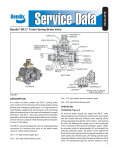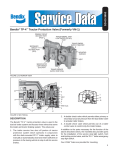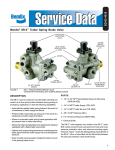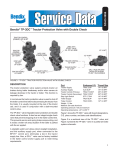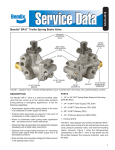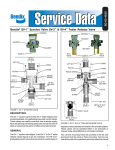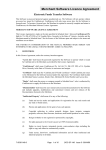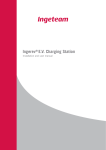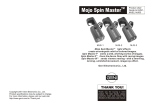Download BENDIX BW1571 User's Manual
Transcript
SD-03-4514 Bendix® SR-4™ Spring Brake Control Valve #2 RESERVOIR CHARGING PORT #2 RESERVOIR CHARGING PORT #1 RESERVOIR CHARGING PORT SERVICE PORT SERVICE PORT #1 RESERVOIR CHARGING PORT DELIVERY PORTS (4) DELIVERY PORTS (4) FIGURE 1A TRAILER SUPPLY PORT TYPE 1 FIGURE 1B TRAILER SUPPLY PORT TYPE 2 FIGURE 1 - SR-4™ SPRING BRAKE CONTROL VALVE TYPE 1 & TYPE 2 DESCRIPTION The SR-4™ valve is provided in two different configurations. Type 1 (Fig. 1A) incorporates a nipple mounted PR-3™ valve. Type 2 (Fig. 1B) has the function of the additional PR-3™ valve integrated into the main housing. There is no difference in the operational performance of the two designs. The SR-4™ trailer spring brake control valve is similar to the SR-2™ valve. It differs in function by utilizing both reservoirs for normal service braking but reserving sufficient air pressure to provide the required spring brake release in the event of a service system failure. As seen in Fig. 1, the complete assembly includes an SR-4™ valve sub-assembly similar in appearance to an SR-2™ valve. The SR-4™ valve subassembly is an SR-2™ valve modified by the addition of a check valve in the spring brake reservoir fitting which permits air to pass from the reservoir to the spring brake inlet valve but not in the opposite direction. AT NO TIME SHOULD AN SR-2™ VALVE BE SUBSTITUTED FOR THE SR-4™ VALVE SUBASSEMBLY. The SR-4™ valve may be identified by the metal tag affixed to the cover by one of four cap screws. Porting is as follows: • 1/2 inch NPT or 3/4 inch NPT spring brake supply port for reservoir mounting • 4-3/8 inch NPT delivery ports • 2-1/4 inch NPT reservoir charging ports • 1-1/4 inch NPT trailer supply port • 1-1/4 inch NPT service port (optional) OPERATION (FIG. 2) CHARGING Air from the trailer supply line enters at the trailer supply port and depresses the control piston "D", opening the spring brake inlet valve "E". It also is conducted to the cavity under the pressure protection piston "F". When air pressure builds to approximately 60 p.s.i. beneath the pressure protection piston, the piston moves against the force of the pressure protection spring and opens the pressure protection inlet valve. The air pressure now flows past check valve “A” into the #2 reservoir and past check valve “B” through the open spring brake inlet valve and into the spring brake 1 SERVICE LINE PRESSURE PROTECTION INLET VALVES PRESSURE PROTECTION PISTON SPRINGS PRESSURE PROTECTION PISTON "F" CHECK VALVE "G" RES. #1 ANTI-COMPOUND LINE PRESSURE PROTECTION PISTON "F" CHECK VALVE “A” RES. #2 CHECK VALVE “B” SUPPLY PORT RELAY VALVE CHECK VALVE “C” SPRING BRAKE INLET VALVE "E" ANTI-COMPOUNDING CHECK VALVE TRAILER SUPPLY LINE CONTROL PISTON "D" SPRING BRAKE FIGURE 2 - SR-4™ VALVE CROSS-SECTIONAL SCHEMATIC units. Air is prevented from flowing from the SR-4™ valve into reservoir #1 by check valve "C". Air simultaneously flows into the PR-3™ pressure protection valve, (Type 1 SR-4™ valve) or the second pressure protection piston (Type 2 SR-4™ valve). At approximately 70 psi piston "F" moves against the resistance of its spring, allowing air to flow through check valve "G" and into reservoir #1. PARK APPLICATION To apply the trailer spring brakes, the trailer supply line is exhausted by means of one of the cab controls. Air pressure is removed from the control piston and the internal pressure protection piston, closing the pressure protection valve and the spring brake inlet valve. SERVICE SYSTEM FAILURE If air pressure is reduced in the service system, pressure in the trailer supply line (and in the tractor) will be reduced until the internal pressure protection valve closes, maintaining 50-60 p.s.i. in the trailer supply line and the tractor service reservoir. This will maintain 50-60 p.s.i. on the control piston which will keep the spring brakes released. At the same time, the reduction in pressure in the tractor system will sound the low pressure signal, alerting the driver. If the service failure is in the #2 reservoir, the air which passes the pressure protection valve will escape through the #2 reservoir and will not be able to resupply the #1 reservoir. The #1 reservoir will retain full pressure because of the pressure protection check valve and check valve “B”. This 2 reserve supply of air will provide at least one spring brake release after a manual application. Service applications may still be made until the air in the #1 reservoir is exhausted. If the service failure is in the #1 reservoir, the pressure protection valve will close and allow air to supply the #2 reservoir. This air will be available to release the spring brake through check valve “B”, although service applications may not be made. EMERGENCY APPLICATION WITH SERVICE SYSTEM FAILURE To brake the trailer after a service system failure, the remaining 55 p.s.i. pressure in the trailer supply line may be exhausted either manually or automatically by the trailer supply valve or parking control valve. The spring brakes are then exhausted through the control piston and thus applied. Sufficient pressure will be maintained in the trailer system to release the spring brakes at least once. ANTI-COMPOUNDING OPTION Under certain conditions when the tractor protection valve goes into the emergency mode during a service application, the trailer supply line will be exhausted but some air may be trapped in the service line, creating a service application plus a full spring application. This creates a false park situation and adds an extra load on the foundation brake components. This may be prevented by adding the optional anti-compounding piping as shown in Figs. 2 & 3. R-12™ RELAY VALVE TRAILER SERVICE LINE ANTI-COMPOUNDING CONNECTION SINGLE CHECK VALVE RES. #1 RES. #2 TRAILER SUPPLY LINE FIGURE 3 - SR-4™ VALVE ANTI-COMPOUNDING PLUMBING PREVENTIVE MAINTENANCE Important: Review the Bendix Warranty Policy before performing any intrusive maintenance procedures. A warranty may be voided if intrusive maintenance is performed during the warranty period. No two vehicles operate under identical conditions, as a result, maintenance intervals may vary. Experience is a valuable guide in determining the best maintenance interval for air brake system components. At a minimum, the SR-4™ valve should be inspected every 6 months or 1500 operating hours, whichever comes first, for proper operation. Should the SR-4™ valve not meet the elements of the operational tests noted in this document, further investigation and service of the valve may be required. SERVICE AND LEAKAGE TESTS Check the tractor dash gauge against a test gauge known to be accurate prior to performing these tests. Connect the tractor air lines to the trailer on which the SR-4™ trailer spring brake valve is to be tested. Block all wheels or hold both vehicles by a means other than air brakes. 1. Install two separate test gauges or one dual test gauge with one line to the #1 reservoir and the other line to the #2 reservoir. Build the tractor and trailer to full system pressure by placing the trailer supply valve in the charge position and the parking control valve in the "brakes released" position. Note: As system pressure reaches approximately 60 p.s.i., the #2 reservoir and the spring brakes should build up to approximately 60 p.s.i. before the #1 reservoir begins to charge (see Fig. 3). When full system pressure has been reached and the spring brakes fully released, it is acceptable to have a slightly lower pressure reading in the service reservoirs than is registered on the dash gauge. Apply a soap solution to the exhaust port and the vent. Leakage of a 1" bubble in 5 seconds is permissible. 2. Place the trailer supply valve in the exhaust position; the spring brakes should apply. Disconnect the trailer supply line and soap the hose coupling to check for leaks. A 1" bubble in not less than 5 seconds is permissible. 3. Reconnect the trailer supply hose coupling and recharge the trailer system. The spring brakes should release. Shut off the engine, leaving the ignition on and open the drain cock on the #1 reservoir. The tractor air system should bleed down to approximately 55 p.s.i. with low pressure, indication occurring at or before 60 p.s.i. The #2 reservoir on the trailer should also bleed down to approximately 55 p.s.i. but the spring brakes on tractor and trailer should remain released. After the system is stabilized, leakage at the open drain cock in the trailer should not exceed a 1" bubble in 5 seconds. 3 4. Close the drain cock on the trailer #1 reservoir, recharge the system, stop the engine and open the drain cock on the #2 reservoir. Again, the tractor air system should bleed down to approximately 45 p.s.i., but the #1 reservoir on the trailer should remain fully charged. The spring brakes should remain released on both the tractor and trailer. Leakage at the open drain cock should not exceed a 1" bubble in 5 seconds. As this test is completed, close the drain cock on the trailer reservoir. 5. If the SR-4™ spring brake valve does not function as described above or leakage is excessive, it is recommended that it be repaired or replaced with a genuine Bendix service replacement valve. WARNING! PLEASE READ AND FOLLOW THESE INSTRUCTIONS TO AVOID PERSONAL INJURY OR DEATH: When working on or around a vehicle, the following general precautions should be observed at all times. 1. Park the vehicle on a level surface, apply the parking brakes, and always block the wheels. Always wear safety glasses. 2. Stop the engine and remove ignition key when working under or around the vehicle. When working in the engine compartment, the engine should be shut off and the ignition key should be removed. Where circumstances require that the engine be in operation, EXTREME CAUTION should be used to prevent personal injury resulting from contact with moving, rotating, leaking, heated or electrically charged components. 3. Do not attempt to install, remove, disassemble or assemble a component until you have read and thoroughly understand the recommended procedures. Use only the proper tools and observe all precautions pertaining to use of those tools. 4. If the work is being performed on the vehicle’s air brake system, or any auxiliary pressurized air systems, make certain to drain the air pressure from all reservoirs before beginning ANY work on the vehicle. If the vehicle is equipped with an AD-IS® air dryer system or a dryer reservoir module, be sure to drain the purge reservoir. 5. Following the vehicle manufacturer’s recommended procedures, deactivate the electrical system in a manner that safely removes all electrical power from the vehicle. 6. Never exceed manufacturer’s recommended pressures. 7. Never connect or disconnect a hose or line containing pressure; it may whip. Never remove a component or plug unless you are certain all system pressure has been depleted. 4 8. Use only genuine Bendix® replacement parts, components and kits. Replacement hardware, tubing, hose, fittings, etc. must be of equivalent size, type and strength as original equipment and be designed specifically for such applications and systems. 9. Components with stripped threads or damaged parts should be replaced rather than repaired. Do not attempt repairs requiring machining or welding unless specifically stated and approved by the vehicle and component manufacturer. 10. Prior to returning the vehicle to service, make certain all components and systems are restored to their proper operating condition. 11. For vehicles with Antilock Traction Control (ATC), the ATC function must be disabled (ATC indicator lamp should be ON) prior to performing any vehicle maintenance where one or more wheels on a drive axle are lifted off the ground and moving. REMOVAL OF VALVE FROM VEHICLE 1. Check the vehicle wheels and drain all air system reservoirs completely. 2. Disconnect all supply, delivery and exhaust lines at the trailer spring brake valve. NOTE: Mark all air lines and their relation to the spring brake valve for reconnection. 3. Remove the spring brake valve from the trailer #1 reservoir. PR-3™ VALVE REMOVAL AND TEST (TYPE 1 SR-4™ VALVE) 1. Remove the PR-3 ™ valve from the SR-4 ™ valve assembly. 2. Apply 50 p.s.i. air pressure at the supply port and apply a soap solution to the delivery port. Leakage of a 1" bubble in 3 seconds is permissible. 3. Apply 100 p.s.i. air pressure at the delivery port. Apply a soap solution to the supply port. No leakage permissible. 4. If the PR-3™ valve does not function as described above or leakage is excessive, it is suggested it be exchanged or replaced at the nearest Bendix distributor. The PR-3™ valve is not considered as serviceable internally. If the PR-3™ valve is disassembled, DO NOT MIX the PR-3™ valve parts with similar looking parts in the main assembly. 1 CHECK VALVE “A” 21 2 20 CHECK VALVE “B” 21 3 5 20 4 15 6 14 7 16 9 CHECK VALVE “C” 26 METAL I.D. TAG 11 10 25 12 24 8 13 23 EXHAUST PORT (17 - SCREW) (18 - WASHER) (19 - DIAPHRAGM) IF EQUIPPED FIGURE 4 SR-4™ VALVE DISASSEMBLY (TYPE 1 REFER TO FIG. 4) REMOVAL AND DISASSEMBLY OF THE PRESSURE PROTECTION PISTON (FIG. 4) 7. Remove the reservoir port fitting (13) from the valve body. 1. Remove the four round head machine screws which secure the spring retainer (1) to the valve body. NOTE: Take caution when removing the spring retainer as it is spring loaded. 8. Remove the o-ring (14) from the reservoir fitting. 2. Remove the spring (2) and pressure protection piston assembly (3). 3. Remove the inlet valve (4) from the piston stem and o-rings (5) from the piston. NOTE: Do not attempt to remove the retaining ring and stem from the piston. REMOVAL AND DISASSEMBLY OF THE CONTROL PISTON 4. Note and mark the position of the control piston cover (6) on the valve body. Remove the four 1/4 inch -20 hex head cap screws and lock washers which retain the cover to the body. 5. Remove the cover, seal ring (7), control piston assembly, and spring (8) from the valve body. 6. From the control piston (9) remove the three o-rings (10, 11 & 12). REMOVAL OF CHECK VALVE “C” 9. Place the reservoir fitting (13) in a vise and remove retaining ring (23), valve retainer (24), spring (25) and check valve (26). 10. Remove the inlet valve spring (15), and inlet and exhaust valve (16). 11. If so equipped, remove the screw (17), washer (18) and diaphragm (19) from the exhaust port. REMOVAL OF THE TWO SINGLE CHECK VALVES “A” & “B” NOTE: Figures 2 and 4 show check valve “A” and check valve “B” out of position for illustration. 12. Remove the two 3/8 inch socket head pipe plugs which retain the two single check valves in the body. 13. Remove the two check valve springs (20), and rubber check valves (21). 5 1 2 3 3 BODY 4 13 END CAP EXHAUST END CAP 12 4 11 4 5 10 9 END CAP 6 7 4 14 8 EXHAUST FIGURE 5 INSETS - VIEWS OF LOCATION OF THE FOUR CHECK VALVE ASSEMBLIES (4) DISASSEMBLY TYPE 2 SR-4™ VALVE (REFER TO FIG. 5) 1. Remove and save the eight cap screws holding the two spring retainers in place. Remove the spring retainers and remove the springs (1 & 2) taking note of the differences and from which cavity it was removed. (One is color coded green the other white.) 2. With a pair of pliers, grasp the raised surface of the two piston assemblies (3) and remove them from the valve body housing. 3. Refer to Fig. 5. With a 5/16 inch Allen Wrench, remove the four 3/8 inch pipe plugs from the SR-4™ valve. (Three are in the main body and one is in the end cap.) Trailers without anti-compounding feature will not have a check valve in the end cover. Remove the four check valve assemblies (4), one under each of the 3/8 inch pipe plugs. 4. Note and mark the position of the end cover to the body. Remove the four cap screws that retain the end cover. Remove the end cover from the body. Remove the sealing ring (5) from the end cover. 5. Remove the large piston from its bore by grasping the web with a pair of pliers and pulling. Remove the spring (6) from the base of the bore. Remove the o-rings (7 & 8) from the piston. 6 6. Remove the check valve assembly from the main body by lightly clamping the body in a vise and turning the check valve assembly counterclockwise with a 1-1/4 inch end wrench. Remove the spring (9) and the inlet/ exhaust valve (10) from the housing. Remove the o-ring (11) from the O.D. of the check valve assembly. 7. With a pair of I.D. snap ring pliers, remove the snap ring in the end of the check valve assembly. Remove the spring seat, the conical spring (12) and the check valve (13). 8. Using a Phillips head screwdriver, remove the Phillips head screw and the diaphragm washer from the exhaust port of the SR-4™ valve body. Remove the diaphragm (14). CLEANING AND INSPECTION 1. Using mineral spirits or an equivalent solvent, clean and thoroughly dry all metal parts. 2. Inspect the interior and exterior or all metal parts that will be reused for severe corrosion, pitting or cracks. Superficial corrosion and/or pitting on the exterior portion of the valve is acceptable. 3. Inspect the bores of the valve housing for deep scuffing or gouges. ASSEMBLY ASSEMBLY - CHECK VALVES “A” AND “B” Prior to reassembling the SR-4™ valve, lubricate all o-rings, o-ring grooves, piston bores, and metal to metal moving surfaces with Bendix silicone lubricant BW-650-M piece number 291126. 1. Twist the check valves (21) into the springs (20) and place in their respective bores, and install the socket head pipe plugs. Torque to 140-170 inch pounds. IMPORTANT NOTE: When pipe thread sealant is used during assembly and reinstallation, particular care should be taken to assure that this material does not get into the valve itself. Pipe sealant should be applied beginning with the second thread back from the end. 1. If so equipped, position the diaphragm (19), washer (18) and screw (17) in the control piston exhaust port. Torque the screw from 15 to 25 inch pounds. ASSEMBLY TYPE 1 SR-4™ VALVE (REFER TO FIG. 4) RESERVOIR FITTING (CHECK VALVE “C”) AND INLET EXHAUST VALVE 1. Place reservoir fitting (13) in a vise, pipe threads down. 2. Insert the check valve (26), check valve spring (25), valve retainers (24), and retaining ring (23). 3. Install the flat inlet exhaust valve into the valve body. NOTE: The flat side of the valve with the four ears protruding rests against the inlet and exhaust seat. 4. Place the inlet exhaust valve spring (15) in positions on the inlet exhaust valve. 5. Properly align the reservoir fitting assembly (13) and install in body. Torque to 200 to 300 inch pounds. ASSEMBLY - CONTROL PISTON AND COVER 6. Install the three o-rings (10, 11 & 12) on the control piston (9). 7. Position the control piston return spring (8) in the body and install the control piston. 8. Install the seal ring (7) in the groove on the control piston cover and assemble the cover to the body. Tighten the cap screw to 40-60 inch pounds. ASSEMBLY - PRESSURE PROTECTION VALVE 9. Install the o-ring (5) on the pressure protection piston (3) and the rubber inlet exhaust valve over the stem. NOTE: Light lubrication of the piston stem will facilitate the rubber valve installation. 10. Install the pressure protection piston assembly in the valve body and position the pressure protection spring on the piston. 11. Position the spring retainer on top of the pressure protection piston assembly and secure with the four round head machine screws. Torque to 20-30 inch pounds. ASSEMBLY - EXHAUST CHECK VALVE ASSEMBLY TYPE 2 SR-4™ VALVE (REFER TO FIG. 5) 1. Install diaphragm (14) into the exhaust port of the SR-4™ valve. Retain with the diaphragm washer and Phillips head screw. Tighten securely. 2. Twist the conical spring (12) onto the spring seat and the opposite end onto the check valve (13), install this subassembly into the check valve housing, depress the spring seat and install the snap ring making sure it is fully seated in its groove. 3. Install the inlet/exhaust valve (10) into the RES-1 port making sure the flat side of the valve is against the inlet seat. Install spring (9) into the valve making sure it is installed over the rubber protrusion of the valve (10). 4. Install the o-ring (11) into the groove on the check valve assembly. Thread the check valve assembly into the RES-1 port. Lightly clamp the SR-4™ valve body in a vise and using a 1-1/4 inch end wrench torque to 150-400 inch pounds. 5. Place the spring (6) into the large bore of the SR-4™ valve body making sure it is seated in the base of the bore. Install the o-ring (7 & 8) onto the piston. Place the piston into the housing with the small end inside of the spring (6). 6. Install the sealing ring (5) into its groove on the end cover. Install the end cover over the piston, installed in Step 5, with the trailer supply port oriented towards the exhaust port. Retain with the four 1/4 inch cap screws, torque to 30-60 inch pounds. 7. Refer to Fig. 2. Install the four check valve assemblies (4) into the cavities of the SR-4™ valve and retain with the 3/8 inch pipe plugs. Removed in Step 3 of “Disassembly”. Apply a thread sealant or Teflon tape to the threads of the pipe plugs and torque to 130-170 inch pounds. 8. Install the two piston assemblies (3) into their cavities, place the spring (1 & 2) over the bosses of the piston assemblies. CAUTION: THE SPRING COLOR CODED WHITE MUST BE INSTALLED ON THE PISTON CLOSEST TO THE END COVER AND THE GREEN COLOR CODED SPRING ON THE PISTON AWAY FROM THE END COVER. Place the spring retainers over the springs and retain with the eight #10 cap screws. Torque to 20-30 inch pounds. 7 INSTALLATION OPERATING AND LEAKAGE TESTS 1. Clean air lines connecting to valve. Check the tractor dash gauge against a test gauge known to be accurate prior to performing these tests. Connect the tractor air lines to the trailer on which the SR-4™ trailer spring brake valve is to be tested. Block all wheels, or otherwise hold both vehicles by a means other than air brakes during these tests. 2. Inspect all lines and/or hoses for damage and replace as necessary. 3. Install valve and tighten. 4. Connect air lines to valve (plug any unused ports). 5. Test valve in accordance with the “Operating and Leakage Tests”. TESTING THE REBUILT SR-4™ VALVE Test the rebuilt SR-4™ valve as explained in “Service and Leakage Tests”. BW1571 © 2007 Bendix Commercial Vehicle Systems LLC. All rights reserved. 7/2007 Printed in U.S.A. 8








